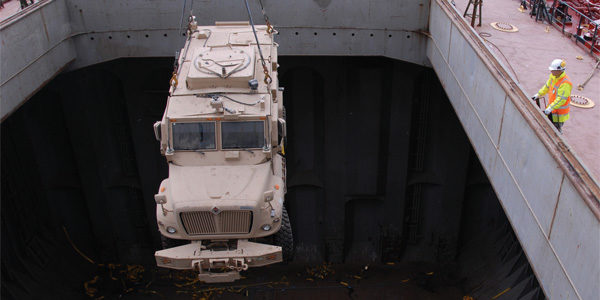Detours of duty: interview with Dr. Stephen Rutner

If Dr. Stephen M. Rutner, professor of supply chain management at Georgia Southern University, seems unusually familiar with the ins and outs of moving large international cargo shipments, there's a reason for that. As it happens, Dr. Rutner is also Lt. Col. Rutner, an Army Reserve logistics specialist who has helped move tens of thousands of pieces of military equipment in and out of the Middle East during two tours of duty at a military port in Kuwait.
Rutner originally trained as a tanker, but along the way the Army Reserve discovered that its armor officer had picked up a Ph.D. in logistics and transportation at the University of Tennessee and adjusted its career plan for the "doctor." The rest, as they say, is history.
Rutner recently returned from his second deployment to the Port of Ash Shuaibah, Kuwait, where he served as commander of the 1181st Transportation Terminal and Deployment Distribution Support Battalion. This is the primary military seaport in Southwest Asia supporting our forces in Iraq. He's Airborne qualified, which means he's trained to parachute into a drop zone, and he has earned a Bronze Star. We suspect that his students are afraid to skip class.
Rutner spoke recently with DC VELOCITY Editor at Large Steve Geary about why the Army is involved in running ports, the challenges of moving a 68-ton tank, and what the military can learn from the commercial sector and vice versa.
 Q: On behalf of DC VELOCITY and our readers, may we thank you for your service?
Q: On behalf of DC VELOCITY and our readers, may we thank you for your service?
A: I appreciate that, but as you go through the airports, please thank all those 18-, 19-, and 20-year-old kids in uniform, not me. They deserve all the pats on the back.
Q: You are both a career academic and a lieutenant colonel in the United States Army Reserves. We all know what a college professor does, but you have now done two tours in Kuwait in an Army uniform working at the military port. Can you give our readers an idea of just what the Army is doing running a port? You think of the Navy when you think of ports.
A: This is one of those little skill sets that is critically important to the entire Department of Defense and the Army, but most people don't understand it. There are 12 reserve battalions just like ours, and our mission is to help the warfighter move through the port system to and from the fight. That means we start all the way up at the foxhole helping them come back to the port, moving through the port, and onto the ships, and back to the United States or vice versa. We meet them at the dock and help them get through the process. Since 2004, I guess it is, possibly back into 2003, reserve battalions have been running that process, and we have moved over 750,000 pieces of military equipment in and out of the theater. In any given month, we might move 6,000 or 7,000 pieces of military equipment.
Q: When you talk about 7,000 pieces of military equipment, we're not talking about typewriters and things like that, are we?
A: Absolutely not. In my world, a small piece of equipment is a 20-foot container. We move lots of containers for the Army as well as pieces of equipment—an M-1 battle tank, a Bradley tank, all the new high-speed MRAP (mine resistant, ambush-protected) armored vehicles, all the trucks, all the support equipment, the bridges, everything for an Army unit to do its mission.
Q: So when we talk about something like a battle tank, just to give a frame of reference, how much does one of those weigh?
A: The M1A1s and A2s that we have seen weigh right around 68 tons. That sounds like a horrific amount of weight, but we are working in an area where we measure things that we load on and off ship in thousands of gross tons. As heavy as an M-1 is, we can probably get 150 of them on one of the big ships if we really need to.
Q: Are military ports a high-volume operation?
A: It depends on the port and where you are in the world. Ash Shuaibah, Kuwait, yes. We are by far the highest-volume port in the entire DOD system. Our sister ports, like Beaumont, Texas; Charleston, S.C.; and Jacksonville, Fla., move large amounts, too, but we tend to be the big dog in the process.
Our sister battalions are running places like Aqaba, Jordan. They are doing the same thing on a much smaller scale. Our sister battalion in Bahrain is moving cargo through Karachi [Pakistan, en route to Afghanistan], but they're doing it all with third-party service providers, no military, and they're moving smaller amounts of cargo.
Part of the training, part of the skill set that the Army has given us is the ability to operate in a high-throughput port like Ash Shuaibah or in an unimproved port and do logistics over the shore, which is painfully slow but still a very important skill set if you are going into a third-world country that doesn't have good port facilities.
Q: Given the breadth of the U.S. Army's capabilities for managing the movement of cargo in and out of ports, are there any lessons learned or any insights you can offer to your commercial counterparts?
A: I would almost argue the military is learning more lessons from the commercial sector than vice versa. For example, the commercial guys are very good at ship handling, very good at throughput because every hour a ship sits on berth is costing money. Our carriers are just driven on time efficiency. Although time is important to us in the military as well, we have other things that are even more important to us. Where the commercial guys are saying, "Well, you are costing me $10,000 an hour for the ship to sit on berth," the military is going, "Yes, but I've got eight more pieces coming from Iraq that have to go to Kuwait and that will be here at the port tomorrow; those eight have to go with that package to get home so that we create a whole unit move." The learning here is the need to take a deep breath and balance some things. One of the lessons that I think the commercial guys could learn from us is that at the end of the day, it is a dollar business on the commercial side, but sometimes that investment of waiting a few hours and building a little flexibility pays off tenfold down the road.
Q: So the military is taking a look at it from an end-to-end supply chain perspective?
A: Absolutely. The commercial carriers that are willing to be flexible and do that, they become the preferred carrier because they are helping the military. Somewhere in Alabama or Georgia, they need that entire package to arrive to keep their system flowing. The carrier is a piece of that supply chain, and when carriers recognize that they are a valuable piece of it, then they become the preferred carrier and all of a sudden, magic things may start happening in their lives. Yes, it could cost them $10,000 here in the port, but if they then become the preferred guy on the list so they get the next bid, which is a $7 million option, it may be worth it six weeks from now.
Q: What important insights are you going to offer to your students at Georgia Southern?
A: The biggest lesson I'm going to bring back into the classroom is the need for young lieutenants and captains on the military side and young zone managers in distribution centers or assistant terminal managers in trucking companies who can see the consequences of their decisions. You need people that can think. In a given situation, what do I do? If you do this, what is going to happen? Is it good, is it bad? How did you think through that process to get to that decision?
Q: Is there anything that you would like to add, any point you would like to raise before we wrap this up?
A: I am grateful to all of those folks who are over there now and wish them Godspeed. There are going to be times when your readers have the ability to help returning veterans, and I hope companies will continue to be there. I hope all your readers will realize what tremendous logisticians they are. You thanked me in the beginning; let me thank all your readers for helping our guardsmen and reservists go serve and reintegrate back into your companies.
Related Articles

Copyright ©2024. All Rights ReservedDesign, CMS, Hosting & Web Development :: ePublishing